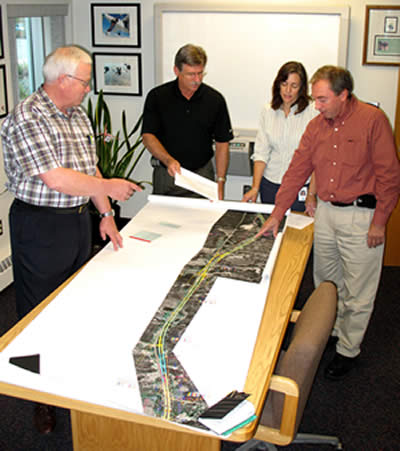By Laurie Gustafson

From left, Dennis Johnson, District 1 planning director;
Mike Robinson, District 1 Transportation Engineer;
Nancy Sannes, cost estimating engineer, and
Mike Tardy, assistant district engineer for program delivery, review the plans for the Hwy 53 expressway project that will take the four-lane highway from the Rice River to Cook. Photo by John Bray |
Editor's note: On Oct. 10, Commissioner Tom Sorel officially marked the completion of the Cost Estimation Process Improvement and Organizational Integration Project and launched the implementation of the new cost estimating and cost management process and guidelines that emerged from the two-year project.
"By enacting these measures, we ensure transparency by communicating our assumptions, while holding ourselves accountable to expectations, and help assure our stakeholders that we can deliver projects on time and within budget," Sorel said.
Something unique is happening in District 1 to implement new scoping, cost estimating and cost management initiatives.
“We created a new position, a program support engineer, to put a strong focus on scoping and cost estimating,” Mike Robinson, District 1 transportation engineer.
“We decided to make changes as part of the whole department focus on better scoping and cost estimating. We want to emphasize doing the job right.”
That focus began in late 2006 when Mn/DOT began a multi-phase project, in collaboration with the Center for Transportation Studies at the University of Minnesota, to achieve accuracy, accountability and consistency in cost estimation and cost management efforts during planning, scoping, design and letting phases of project delivery.
Mike Tardy, assistant district engineer, spearheaded organizational changes in District 1 to implement scoping, cost estimating and cost management.
District 1 hired Nancy Sannes, formerly an estimating engineer in the Office of Technical Services, for the new position. She works with engineers across functional areas, such as bridge, hydraulics and land management, to develop cost estimates.
When District 1 managers decided to focus on improved scoping and cost estimating, they knew they needed to make some changes. Project managers develop the scope for the project before it enters the State Transportation Improvement Program, but now Sannes works as an independent resource to develop a detailed cost estimate that accompanies the project’s scoping report.
“With this approach, we will gain a more uniform process,” Robinson said. “We’ve defined who will do the work—independent from the project manager.”
Once a project enters STIP, Sannes works with the project manager to limit changes in scope that affect the cost estimate.
“We’ve also instituted stronger accountability for the project managers to manage projects within the estimate,” Robinson said.
Robinson believes that by achieving better outcomes, stakeholder expectations will be met as projects are delivered within budget and on time.
“Our stakeholders get frustrated, understandably so, when project timelines shift because a different project exceeded scope,” he said. “When we deliver projects as planned, we become more credible.”
As staff gain experience, Robinson wants to be sure that they look far enough in advance to identify the real needs of a project.
“We have to take a comprehensive view of projects and not overlook anything that could dramatically change the scope or cost estimate.
“Our goal is to do it right the first time and early in the project development,” he said. “There will always be uncertainties. We want to work hard to minimize those uncertainties.”
For more information, visit www.dot.state.mn.us/cost-estimating and Newsline, Workshop applies key concepts of cost estimating to newly funded projects (April 10, 2008) and Project addresses cost escalation issues (Nov. 28, 2007). |



